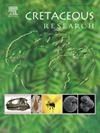Comment on «Microlepia burmasia sp. nov., a new fern species from mid-Cretaceous Kachin amber of norther Myanmar (Dennstaedtiaceae, Polypodiales) » [Cretaceous Research 143 (2023) 105417]
IF 1.7
3区 地球科学
Q1 GEOLOGY
引用次数: 0
Abstract
“Microlepia” burmasia is a recently described eupolypod fern from mid-Cretaceous Burmese amber by Long et al. (2023). According to the latest taxonomic system of ferns, “M.” burmasia belongs to the Dennstaedtiaceae, Polypodiales. Discovery of “M.” burmasia means the origin of the genus can be pushed back by at least 99 Ma. The specimen provides new information on the floral diversity of the Kachin amber forest and new insight to the origin of Microlepia and Dennstaedtiaceae (Long et al., 2023). However, a careful review of the illustrations and descriptions of the sporangium and spore in the manuscript showed that the polar axial length and equatorial length of the spores were three to six times that of the spores in the extant and fossil Microlepia species, and nearly the same size as the sporangium, and the sporangium morphology and spore size are very different from that of any other polypod species. In an effort to further investigate the systematic position of “Microlepia” burmasia, its spore morphology and size were compared with those of the entire Dennstaedtiaceae and to all fern families possessing trilete spores. Comparative analyses reveal some similarities only with Anemia subgenus Coptophyllum (Anemiaceae). However, the sporangium morphology of “Microlepia” burmasia does not align with Anemiaceae. Given these discrepancies, it is recommended to reconsider the placement of “Microlepia” burmasia within Polypodiales and its systematic placement needs further study.
关于 "Microlepia burmasia sp.
"Microlepia "burmasia是Long等人(2023年)最近从白垩纪中期缅甸琥珀中描述的一种多足蕨类植物。根据最新的蕨类植物分类系统,"M. "burmasia隶属于Dennstaedtiaceae,Polypodiales。发现 "M. burmasia "意味着该属的起源可以推前至少 99 Ma。该标本为克钦琥珀森林的花卉多样性提供了新的信息,并为 Microlepia 和 Dennstaedtiaceae 的起源提供了新的见解(Long 等人,2023 年)。然而,仔细查阅手稿中关于孢子囊和孢子的插图和描述后发现,孢子的极轴长度和赤道长度是现生和化石Microlepia物种孢子的三至六倍,与孢子囊的大小几乎相同,孢子囊形态和孢子大小与其他任何多足类物种都有很大差异。为了进一步研究 "Microlepia "burmasia的系统定位,我们将其孢子形态和大小与整个蕨类植物科(Dennstaedtiaceae)以及所有拥有三叶孢子的蕨类植物科的孢子形态和大小进行了比较。比较分析显示,它与 Anemia 亚属 Coptophyllum(茴芹科)有一些相似之处。不过,"Microlepia" burmasia 的孢子囊形态与 Anemiaceae 并不一致。鉴于这些差异,建议重新考虑 "Microlepia" burmasia 在多足纲中的位置,其系统位置需要进一步研究。
本文章由计算机程序翻译,如有差异,请以英文原文为准。
求助全文
约1分钟内获得全文
求助全文
来源期刊

Cretaceous Research
地学-地质学
CiteScore
4.10
自引率
19.00%
发文量
235
审稿时长
12 weeks
期刊介绍:
Cretaceous Research provides a forum for the rapid publication of research on all aspects of the Cretaceous Period, including its boundaries with the Jurassic and Palaeogene. Authoritative papers reporting detailed investigations of Cretaceous stratigraphy and palaeontology, studies of regional geology, and reviews of recently published books are complemented by short communications of significant new findings.
Papers submitted to Cretaceous Research should place the research in a broad context, with emphasis placed towards our better understanding of the Cretaceous, that are therefore of interest to the diverse, international readership of the journal. Full length papers that focus solely on a local theme or area will not be accepted for publication; authors of short communications are encouraged to discuss how their findings are of relevance to the Cretaceous on a broad scale.
Research Areas include:
• Regional geology
• Stratigraphy and palaeontology
• Palaeobiology
• Palaeobiogeography
• Palaeoceanography
• Palaeoclimatology
• Evolutionary Palaeoecology
• Geochronology
• Global events.
 求助内容:
求助内容: 应助结果提醒方式:
应助结果提醒方式:


